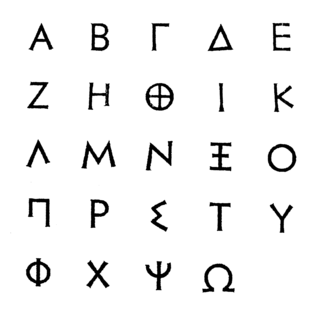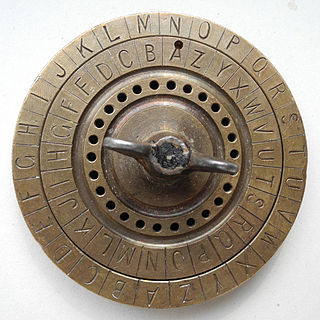
Braille is a tactile writing system used by people who are visually impaired. It can be read either on embossed paper or by using refreshable braille displays that connect to computers and smartphone devices. Braille can be written using a slate and stylus, a braille writer, an electronic braille notetaker or with the use of a computer connected to a braille embosser.

In cryptography, a cipher is an algorithm for performing encryption or decryption—a series of well-defined steps that can be followed as a procedure. An alternative, less common term is encipherment. To encipher or encode is to convert information into cipher or code. In common parlance, "cipher" is synonymous with "code", as they are both a set of steps that encrypt a message; however, the concepts are distinct in cryptography, especially classical cryptography.

The Global System for Mobile Communications (GSM) is a standard developed by the European Telecommunications Standards Institute (ETSI) to describe the protocols for second-generation (2G) digital cellular networks used by mobile devices such as mobile phones and tablets. GSM is also a trade mark owned by the GSM Association. GSM may also refer to the Full Rate voice codec.
In telecommunications, a scrambler is a device that transposes or inverts signals or otherwise encodes a message at the sender's side to make the message unintelligible at a receiver not equipped with an appropriately set descrambling device. Whereas encryption usually refers to operations carried out in the digital domain, scrambling usually refers to operations carried out in the analog domain. Scrambling is accomplished by the addition of components to the original signal or the changing of some important component of the original signal in order to make extraction of the original signal difficult. Examples of the latter might include removing or changing vertical or horizontal sync pulses in television signals; televisions will not be able to display a picture from such a signal. Some modern scramblers are actually encryption devices, the name remaining due to the similarities in use, as opposed to internal operation.

A smart card (SC), chip card, or integrated circuit card, used to control access to a resource. It is typically a plastic credit card-sized card with an embedded integrated circuit (IC) chip. Many smart cards include a pattern of metal contacts to electrically connect to the internal chip. Others are contactless, and some are both. Smart cards can provide personal identification, authentication, data storage, and application processing. Applications include identification, financial, public transit, computer security, schools, and healthcare. Smart cards may provide strong security authentication for single sign-on (SSO) within organizations. Numerous nations have deployed smart cards throughout their populations.

Dynamic random-access memory is a type of random-access semiconductor memory that stores each bit of data in a memory cell, usually consisting of a tiny capacitor and a transistor, both typically based on metal–oxide–semiconductor (MOS) technology. While most DRAM memory cell designs use a capacitor and transistor, some only use two transistors. In the designs where a capacitor is used, the capacitor can either be charged or discharged; these two states are taken to represent the two values of a bit, conventionally called 0 and 1. The electric charge on the capacitors gradually leaks away; without intervention the data on the capacitor would soon be lost. To prevent this, DRAM requires an external memory refresh circuit which periodically rewrites the data in the capacitors, restoring them to their original charge. This refresh process is the defining characteristic of dynamic random-access memory, in contrast to static random-access memory (SRAM) which does not require data to be refreshed. Unlike flash memory, DRAM is volatile memory, since it loses its data quickly when power is removed. However, DRAM does exhibit limited data remanence.

In the history of cryptography, the ECM Mark II was a cipher machine used by the United States for message encryption from World War II until the 1950s. The machine was also known as the SIGABA or Converter M-134 by the Army, or CSP-888/889 by the Navy, and a modified Navy version was termed the CSP-2900.

Coding theory is the study of the properties of codes and their respective fitness for specific applications. Codes are used for data compression, cryptography, error detection and correction, data transmission and data storage. Codes are studied by various scientific disciplines—such as information theory, electrical engineering, mathematics, linguistics, and computer science—for the purpose of designing efficient and reliable data transmission methods. This typically involves the removal of redundancy and the correction or detection of errors in the transmitted data.
Cryptography, the use of codes and ciphers to protect secrets, began thousands of years ago. Until recent decades, it has been the story of what might be called classical cryptography — that is, of methods of encryption that use pen and paper, or perhaps simple mechanical aids. In the early 20th century, the invention of complex mechanical and electromechanical machines, such as the Enigma rotor machine, provided more sophisticated and efficient means of encryption; and the subsequent introduction of electronics and computing has allowed elaborate schemes of still greater complexity, most of which are entirely unsuited to pen and paper.

The Polybius square, also known as the Polybius checkerboard, is a device invented by the ancient Greeks Cleoxenus and Democleitus, and made famous by the historian and scholar Polybius. The device is used for fractionating plaintext characters so that they can be represented by a smaller set of symbols, which is useful for telegraphy, steganography, and cryptography. The device was originally used for fire signalling, allowing for the coded transmission of any message, not just a finite number of predetermined options as was the convention before.
Pirate decryption is the decryption, or decoding, of pay TV or pay radio signals without permission from the original broadcaster. The term "pirate" is used in the sense of copyright infringement. The MPAA and other groups which lobby in favour of intellectual property regulations have labelled such decryption as "signal theft" even though there is no direct tangible loss on the part of the original broadcaster, arguing that losing out on a potential chance to profit from a consumer's subscription fees counts as a loss of actual profit.
The Secure Communications Interoperability Protocol (SCIP) is a US standard for secure voice and data communication, for circuit-switched one-to-one connections, not packet-switched networks. SCIP derived from the US Government Future Narrowband Digital Terminal (FNBDT) project. SCIP supports a number of different modes, including national and multinational modes which employ different cryptography. Many nations and industries develop SCIP devices to support the multinational and national modes of SCIP.
Secure communication is when two entities are communicating and do not want a third party to listen in. For this to be the case, the entities need to communicate in a way that is unsusceptible to eavesdropping or interception. Secure communication includes means by which people can share information with varying degrees of certainty that third parties cannot intercept what is said. Other than spoken face-to-face communication with no possible eavesdropper, it is probable that no communication is guaranteed to be secure in this sense, although practical obstacles such as legislation, resources, technical issues, and the sheer volume of communication serve to limit surveillance.
Conditional access (CA) is a term commonly used in relation to software and to digital television systems. Conditional access is that ‘just-in-time’ evaluation to ensure the person who is seeking access to content is authorized to access the content. Said another way, conditional access is a type of access management. Access is managed by requiring certain criteria to be met before granting access to the content.

A cipher disk is an enciphering and deciphering tool developed in 1470 by the Italian architect and author Leon Battista Alberti. He constructed a device, consisting of two concentric circular plates mounted one on top of the other. The larger plate is called the "stationary" and the smaller one the "moveable" since the smaller one could move on top of the "stationary".

FreeOTFE is a discontinued open source computer program for on-the-fly disk encryption (OTFE). On Microsoft Windows, and Windows Mobile, it can create a virtual drive within a file or partition, to which anything written is automatically encrypted before being stored on a computer's hard or USB drive. It is similar in function to other disk encryption programs including TrueCrypt and Microsoft's BitLocker.

Network Security Services (NSS) is a collection of cryptographic computer libraries designed to support cross-platform development of security-enabled client and server applications with optional support for hardware TLS/SSL acceleration on the server side and hardware smart cards on the client side. NSS provides a complete open-source implementation of cryptographic libraries supporting Transport Layer Security (TLS) / Secure Sockets Layer (SSL) and S/MIME. NSS releases prior to version 3.14 are tri-licensed under the Mozilla Public License 1.1, the GNU General Public License, and the GNU Lesser General Public License. Since release 3.14, NSS releases are licensed under GPL-compatible Mozilla Public License 2.0.

Cryptography, or cryptology, is the practice and study of techniques for secure communication in the presence of adversarial behavior. More generally, cryptography is about constructing and analyzing protocols that prevent third parties or the public from reading private messages. Modern cryptography exists at the intersection of the disciplines of mathematics, computer science, information security, electrical engineering, digital signal processing, physics, and others. Core concepts related to information security are also central to cryptography. Practical applications of cryptography include electronic commerce, chip-based payment cards, digital currencies, computer passwords, and military communications.

BATCO, short for Battle Code, is a hand-held, paper-based encryption system used at a low, front line level in the British Army. It was introduced along with the Clansman combat net radio in the early 1980s and was largely obsolete by 2010 due to the wide deployment of the secure Bowman radios. BATCO consists of a code, contained on a set of vocabulary cards, and cipher sheets for superencryption of the numeric code words. The cipher sheets, which are typically changed daily, also include an authentication table and a radio call sign protection system.

In the history of cryptography, 91-shiki ōbun injiki or Angōki Taipu-A, codenamed Red by the United States, was a diplomatic cryptographic machine used by the Japanese Foreign Office before and during World War II. A relatively simple device, it was quickly broken by western cryptographers. The Red cipher was succeeded by the Type B "Purple" machine which used some of the same principles. Parallel usage of the two systems assisted in the breaking of the Purple system.














